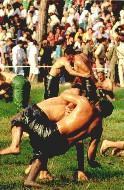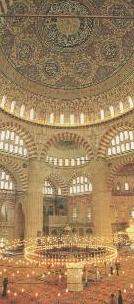|
|

|
|
Edirne
|
The Uc Serefeli Mosque, built between 1438 and 1447 by Mural I, presages the great period of Ottoman mosque architecture under Sinan and embodies both a new freedom from restraint and advances in engineering. The northwest minaret has three galleries, hence the mosque's name and was the highest minaret until those of the Selimiye Mosque eclipsed it. Towards the end of the 15th century, Beyazit II commissioned the architect Hayrettin to build him a complex in Edirne which includes a mosque, Darussifa (hospital), medrese, kitchen and store rooms. The mosque is square in plan and covered with a deep dome; over 100 domes roof the remainder. The most important of the other buildings is the Daruissifa which stood out in its time as a modern hospital with a unique and humane architectural design. Little has changed in the Kaleici section of Edirne since the Middle Ages. Narrow streets lined with houses wind through the area. The number of small restaurants and cafes reflect the district's renaissance. |

|
|---|
|
Sinan built several of the famous baths in Edirne including the Sokollu, Tahtakale, Mezit Bey, Beylerbeyl and Gazi Mihal hamams. His work is also seen in the Ahmet Pasa Caravanseral and the Rustem Pasa Caravanserai of 1561. The last has been renovated and serves as a charming hotel. The old bedesten of the early 15th century still functions as Edirne's main market. As you drive around the area you should notice the many lovely Ottoman bridges which grace the Tunca and Meric Rivers. Edirne has retained many of its colonful traditions and customs. Every summer where the Tunca River divides an emerald green meadow is created called Sarayici, where the Kirkpinar Greased Wrestling Contests are held. Shiny, slippery bodies grapple to determine who will emerge as champion. As you walk through the city and peer into the corners of the grocery stores, you see blocks of white feta cheese, a local speciality. Hardariye, another of the city's delicacies, is a grape drink mixed with mustard and marzipan. Scented soaps, earthenware pots and straw baskets from Edirne make good souvenirs. You will find it dirticult to resist the beautiful embroidery work of the local women. The Archaeological and Ethnographical Museum traces the history of the area from prehistoric to Byzantine times and exhibits clothing from the late Ottoman period. At the Turkish Islamic Art Museum examples of Ottoman architectural details, calligraphy, manuscripts, Korans. weapons, glass and an imperial tent used on military campaigns are displayed. On the way to the Saroz Gulf in the Aegean Sea, you can stop at Uzunkopru to see an interesting bridge spanning the Ergene River, nuilt by Murat II in 1444. Its 174 arches. the highest of which is 12.28 meters, make up its 1354 meter length. The mild climate and beautiful surroundings on the Saroz Gulf invite holiday makers for a break of relaxation. Whether here or in Edirne, the hotel and guest-house facilities are plentiful and reasonably priced. |

|

|


This site prepared by Tayfun Kalyoncu on 28.02.1997 and last updated on 01.05.1999.
For any comments and suggestion please send an e-mail using the form at page mailform.html
